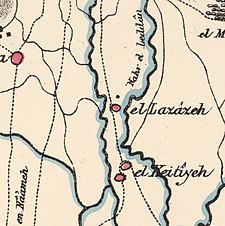Lazzaza
Lazzaza
لزّازة | ||
|---|---|---|
Village | ||
| Etymology: “fastening”,[1] | ||
A series of historical maps of the area around Lazzaza (click the buttons) | ||
Geopolitical entity Mandatory Palestine | | |
| Subdistrict | Safad | |
| Date of depopulation | May 21, 1948[4] | |
| Area | ||
| • Total | 1,586 dunams (1.586 km2 or 392 acres) | |
| Population (1945) | ||
| • Total | 230[2][3] | |
| Cause(s) of depopulation | Whispering campaign | |
| Current Localities | Beit Hillel. | |
Lazzaza (
Safad.[5] Beit Hillel
subsequently expanded onto the land.
History
In 1881, the PEF's Survey of Western Palestine (SWP) described Lazzaza, while under Ottoman rule, as a village of 70 people built of adobe bricks and situated on a plain near a river.[6]
British Mandate era
It was incorporated into the
Muslims, took advantage of the village's fertile lands, and agriculture became the basis of its economy. The primarily cultivated crops were onions, corn, and fruits, but the beehives were also kept, in addition to some livestock. Some of Lazzaza's inhabitants also fished in the Hasbani River.[5]
In the 1931 census of Palestine the population of Lazaza was 176, all Muslims, in a total of 39 houses.[7]
In the
Jewish settlement of Beit Hillel which together constituted a population of 330; 230 were Muslims of Lazzaza, the remaining 100 were Jewish of Beit Hillel.[2][3]
Types of land use in dunams in the village in 1945:[8][9]
| Land Usage | Arab | Jewish |
|---|---|---|
| Irrigated and plantation | 235 | 805 |
| Cereal | 95 | 119 |
| Cultivable | 330 | 924 |
| Urban | 27 | 18 |
| Non-cultivable | 20 | 0 |
The land ownership of the village before occupation in dunams:[3]
| Owner | Dunams |
|---|---|
| Arab | 377 |
| Jewish | 942 |
| Public | 267 |
| Total | 1,586 |
1948, aftermath
The Arabs of Lazzaza fled their village during the
1948 Arab-Israeli War on May 21, 1948.[4] The village was not attacked by Israeli forces, and the probable cause of its depopulation was a "whispering campaign" devised by Palmach commander Yigal Allon during Operation Yiftach, in which rumor would spread about massive Jewish reinforcements approaching the Galilee. According to Walid Khalidi, "only a few scattered houses remain on the village site", and that the residents of Beit Hillel cultivate the surrounding fields.[5]
See also
- Depopulated Palestinian locations in Israel
References
- ^ Palmer, 1881, p. 29
- ^ a b Department of Statistics, 1945, p. 10
- ^ a b c Government of Palestine, Department of Statistics. Village Statistics, April, 1945. Quoted in Hadawi, 1970, p. 70
- ^ a b Morris, 2004, p. xvi, village #8. Also gives cause of depopulation.
- ^ a b c Khalidi, 1992, p.469.
- ^ Conder and Kitchener, 1881, SWP I, p. 89. Quoted in Khalidi, 1992, p.469.
- ^ Mills, 1932, p. 108
- ^ Government of Palestine, Department of Statistics. Village Statistics, April, 1945. Quoted in Hadawi, 1970, p. 119
- ^ Government of Palestine, Department of Statistics. Village Statistics, April, 1945. Quoted in Hadawi, 1970, p. 169
Bibliography
- Conder, C.R.; Kitchener, H.H. (1881). The Survey of Western Palestine: Memoirs of the Topography, Orography, Hydrography, and Archaeology. Vol. 1. London: Committee of the Palestine Exploration Fund.
- Department of Statistics (1945). Village Statistics, April, 1945. Government of Palestine.
- Hadawi, S. (1970). Village Statistics of 1945: A Classification of Land and Area ownership in Palestine. Palestine Liberation Organization Research Centre.
- ISBN 0-88728-224-5. *Mills, E., ed. (1932). Census of Palestine 1931. Population of Villages, Towns and Administrative Areas. Jerusalem: Government of Palestine.
- Mills, E., ed. (1932). Census of Palestine 1931. Population of Villages, Towns and Administrative Areas. Jerusalem: Government of Palestine.
- ISBN 978-0-521-00967-6.
- Palmer, E.H. (1881). The Survey of Western Palestine: Arabic and English Name Lists Collected During the Survey by Lieutenants Conder and Kitchener, R. E. Transliterated and Explained by E.H. Palmer. Committee of the Palestine Exploration Fund.
External links
- Welcome to Lazzaza
- Lazzaza, Zochrot
- Lazzaza, Dr. Khalil Rizk.
- Survey of Western Palestine, map 2: IAA, Wikimedia commons
- Lazzaza, from the Khalil Sakakini Cultural Center





